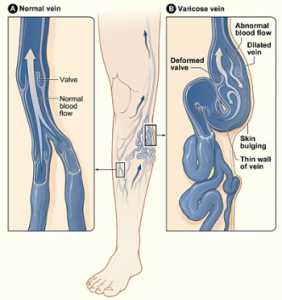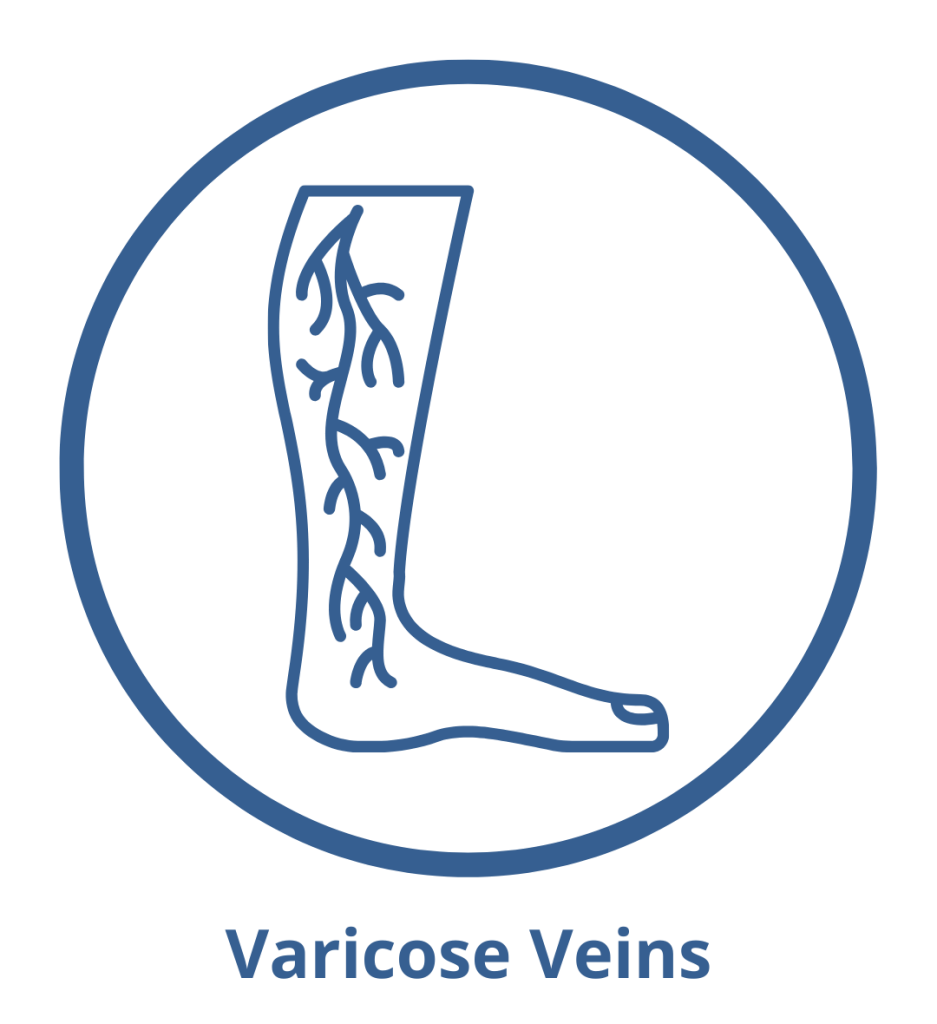Varicose Veins FAQs
Common questions about varicose veins
Have questions about varicose veins? We answer them below:

Varicose veins are abnormally enlarged, dilated, twisted superficial veins, which can be blue or purple in colour. They often occur in the legs and can be a cause of pain, itching, ache and irritation in the legs. The good news is that in the majority of cases they do not cause any health problems. However, they do not look nice and people often want some form of treatment to control the appearance.
In some people, varicose veins may bleed, cause severe pain and swelling and even lead to ulcers, requiring specific medical treatments.
Blood returning to the heart travels through the veins in our body and blood in the legs has a hard job because it has to fight against gravity. Veins have valves to assist the blood flow against forces such as gravity.
Failure of these valves causes a build up of blood and pressure causing stagnation and reflux which ultimately leads to varicose veins. This is called venous insufficiency. Science has not yet determined exactly what makes these valves fail, but there are some important risk factors.
Some important risk factors include:
- Age- the older we get, the more prone we are to varicose veins.
- Family history- varicose veins do run in families.
- Gender- women are more prone, especially women who have had children.
- Pregnancy- especially women who have had multiple pregnancies.
- Occupation- jobs requiring prolonged standing can raise the probability of having varicose veins.
- A past history of deep vein thrombosis (DVT)– this raises the risk of having varicose veins and their complications.
People often complain that their varicose veins look terrible, but have no other symptoms. This in itself is a reason to seek treatment for some people.
Varicose veins and venous insufficiency can also cause aching pain, leg swelling, a heavy or easily tired leg, especially at the end of the day. In more severe cases, darkening or discoloration of the skin can occur, as well as wounds or ulcers that may not heal for a long time. Occasionally these veins can bleed, either under the skin causing bruising or as an open wound, which can be quite alarming.
Other symptoms can include:
- Spider veins
- Shiny or tight skin in the calves. There may also be hardening of the skin and tissues due to longstanding damage to the fat and tissues of the leg by varicose veins.
- Dry and itch skin in the lower leg.
- People with varicose veins are at higher risk of restless leg syndrome.
Chronic venous disease, including varicose veins, is extremely common. It affects half the population. 1 in 2 people over 50 years of age and 15-25% of all adults will have varicose veins.
Dr Vrazas will perform a careful physical examination, which will diagnose varicose veins. Before any treatment can be recommended, a color duplex ultrasound examination will be performed by the dedicated MIVIR Vascular Ultrasound service.
This is absolutely necessary to rule out important associated problems such as DVT.
This examination will also map out the abnormal veins, assess valve function, and abnormal patterns of blood flow. This will help determine which treatment is best for you.
Prominent spider veins can be treated by ultrasound guided injection treatments or by surface laser.
Larger veins may require a laser ablation (endovenous laser treatment) treatment, which may be combined with injection sclerotherapy. This minimally invasive treatment can treat the majority of varicose vein patients and is performed at our clinic as an outpatient procedure.
Rarely, surgery may be required to treat very large or inaccessible varicose veins.
This procedure is performed under local anaesthetic which may be combined with a mild sedative.
Ultrasound guidance is used to access the abnormal vein just below the knee and local anaesthetic is injected. A small needle is inserted into the abnormal vein, followed by a tiny plastic tube called a catheter which will guide the laser fibre into the vein.
These instruments are directed to the top of the abnormal vein and more local anaesthetic is injected. The laser is then activated and this energy heats and seals the vein. Before the catheter is removed, further injections may be required to treat smaller, abnormal branch veins.
This treatment is called injection sclerotherapy and is performed using chemicals which irritate the vein and cause it to scar.
Upon completion of the treatment, the catheters will be removed and pressure applied. The leg will be wrapped in compressive dressing and the patient will be given a tight compression stocking to wear.
This treatment involves ultrasound- guided injections of chemicals, which have been prepared as a foam. They aim to scar the abnormal veins. Direct ultrasound guidance makes this a highly accurate and effective technique in vein treatment, more than injecting these veins without ultrasound guidance. It also significantly reduces complications. Learn more about the procedure here.
The procedure usually takes an hour for one leg and up to 90 minutes if both legs require treatment. You will then be recovered in our dedicated recovery room, where you will receive post procedural instructions and care. Learn more about what to expect on the day of your procedure here.
Most patients return to work the day after their procedure. Some people can return to work the same day.
You will need to wear the compression stockings for 4 days continuously, after which you will be required to wear them only during the day (off at night) for 2 weeks.
No, these veins are abnormal and have long since been made redundant by the body. New veins have developed to take blood back to the heart. The abnormal varicose veins serve no purpose.
If correctly treated, the abnormal veins will not return. However, new varicose veins can develop over time because the underlying factors that caused the problem still exist.
Laser treatment for reticular or spider veins in the legs has been disappointing and not long lasting. However, laser can be useful for tiny veins on face.
Sclerotherapy has been performed on millions of patients over the last 40 years and has a very good safety record.
Similarly, endovenous laser ablation and radiofrequency have had similar safety profiles over 10 years since their introduction.
Of course, treatment is not always necessary and is a valid option. Having varicose veins is not a serious medical condition and often causes no harm aside from cosmetic issues.
Compression stockings are a good way to manage chronic leg swelling and discomfort due to varicose veins and once properly fitted, compression stockings can be a very effective treatment alternative.
Ultrasound guided injection sclerotherapy is very effective at managing very small to medium sized abnormal veins.
Endovenous ablation using laser or Clarivein treatment. Clarivein is a catheter based treatment which aims to destroy the vein using a combination of a mechanically powered catheter which spins, damaging the vein wall, combined with sclerosant material injected through this catheter. It has a lower incidence of complications than laser ablation but may not be as effective as still requires the use of sclerosant chemicals.
Ambulatory phlebectomy involves the surgical removal of large varicosities under local anesthetic in an office setting. Combined with other treatments such as injection sclerotherapy and endovenous laser treatment, it can be very effective at controlling focal areas of troublesome large varicose veins.
Surgery, using the traditional and longstanding practice of stripping and phlebectomy, is still a very reasonable yet much more invasive option. In some patients, particularly those who have exceptionally large veins or allergies or sensitivities to the sclerosant medicines used in sclerotherapy, surgery is an excellent alternative.
Although smaller varicose veins can be treated very effectively and rapidly, producing excellent results in 1-2 months, most larger veins will require some more time, and possibly additional procedures to achieve an acceptable cosmetic result. Patience is required as these treatments, being minimally invasive, require time for sclerosants to work, and time for the body to heal the inflammation and the results of laser ablative effects. Unfortunately, perfection cannot be guaranteed.
Important points to note about all varicose vein treatments:
- Not all patients need treatment
- Multiple treatment sessions may be necessary
- Cosmetic perfection may not be achievable despite excellent technique
- Recovery from treatments may be prolonged
- Complications can occur, as with any medical treatment, but they are fortunately minor
- Skin pigmentation can occur and is due to trapped blood, which when broken down by the body, produces iron containing pigments. These can take a long time to disperse and in the great majority of patients, will improve considerably. However, it can persist in some patients and be a cause for concern. If this is a serious concern, consideration should be given to non-injection treatments such as surgery.
- Varicose veins are a chronic problem that can recur. We are merely treating the symptoms, not curing the underlying cause which is often complex, multifactorial and hereditary. The treated veins do not return, but new ones can develop. These new veins can be treated the same way.
- It is not advisable to treat varicose veins during pregnancy or lactation. Pregnancy does make veins more prominent, but they often improve after the baby is delivered. There is no need to wait until you have finished having children to have your veins treated. These treatments can be easily repeated.
Author: Dr John Vrazas

